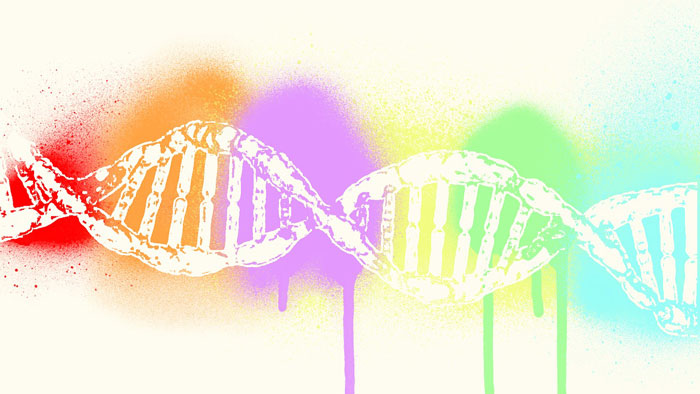Guest post contributed by members of the GSA Early Career Scientist Communications and Outreach Subcommittee.
In their bitter war with crop pests, farmers have two big guns: chemical pesticides and genetic engineering. But excitement has been building in the farming community for a new weapon that is unlike anything they’ve tried before, a pesticide 2.0. Highly selective and non-toxic, yet applied using the conventional methods of pesticide sprays, this approach exploits an ancient biological process to turn the pest’s own genes against it. But the new farming tool is just one use of a technology— RNAi —that is primed to fight a host of other major global challenges, including human disease. Farmers may well be at the frontlines of an RNAi revolution.
What is RNAi?
RNAi is a natural process that occurs in almost all organisms, from crop plants to insect pests to mice. Short for RNA interference, it is a form of protection against invading RNA. RNA is a chemical similar to DNA, and it helps translate the genetic code into action. Like DNA, it is found in every living thing and is highly specific to the particular species it came from. Some viruses even use RNA in place of DNA as their heritable code. Cells need to be able to recognize foreign RNA, such as from infecting viruses, which is where RNAi comes in. Two key RNAi proteins called Dicer and Slicer recognize, break apart, and destroy the invading RNA molecules.
This system was first discovered in the model worm Caenorhabditis elegans by Craig Mello, Andrew Fire, and their teams. Simply by injecting short pieces of RNA into their worms, they could “interfere” with the function of specific C. elegans genes. The scientists were able to target the genes of their choice; if they knew the gene’s DNA sequence they could design a corresponding RNA sequence that would set Dicer and Slicer on the attack. The superpower potential of RNAi was quickly appreciated and a Nobel Prize was awarded to Mello and Fire in 2006, just 8 short years after their original publication.
RNAi on the farm
 Since its discovery, scientists have dreamed up a huge range of potential applications of RNAi, including sprayable solutions that silence selected genes in agricultural pests. To make such RNAi spray pesticides, genes specific to a particular pest are targeted with specially designed RNA molecules. Part of the beauty of this approach is that it can be directly deployed by farmers with no additional time or effort compared to traditional pesticide sprays. The RNA mix is either sprayed on the target insects or is taken up by the plants through their roots and then consumed by the insects. RNAi is also effective at lower doses than traditional pesticides. Combining RNAi with traditional pesticide treatments should reduce chemical inputs onto fields and reduce resistance of insects to those chemicals.
Since its discovery, scientists have dreamed up a huge range of potential applications of RNAi, including sprayable solutions that silence selected genes in agricultural pests. To make such RNAi spray pesticides, genes specific to a particular pest are targeted with specially designed RNA molecules. Part of the beauty of this approach is that it can be directly deployed by farmers with no additional time or effort compared to traditional pesticide sprays. The RNA mix is either sprayed on the target insects or is taken up by the plants through their roots and then consumed by the insects. RNAi is also effective at lower doses than traditional pesticides. Combining RNAi with traditional pesticide treatments should reduce chemical inputs onto fields and reduce resistance of insects to those chemicals.
RNAi success stories are beginning to emerge from the field. The Asian citrus psyllid carries a pathogen that causes citrus greening disease, costing the citrus industry billions of dollars in lost crops and even more in lost jobs. Researchers targeted the insects by applying an RNAi pesticide to the trees, which was absorbed and spread to the stems and leaves. The insects then fed on the trees as nymphs, and all the adult insects died. Importantly, because the trees’ genomes are distinct from the insects’ genomes, the trees themselves are unaffected by the RNA.
Despite the high-tech origins of this approach, RNAi deployed this way does not permanently alter the genetic code of the plant, insect, or pathogen, so this technology is not classified as genetic modification. Even though genetically modified crops are well established by the scientific community as safe, consumer fear has continued to hold back acceptance of these products. Of course, there are also powerful ways to combine RNAi with genetic modification, such as enhancements to boost healthy carotenoids and beta-carotene in tomatoes and oranges, or a reduction in food sensitivity triggers such as lower-gluten wheat.
Importantly, an EPA panel in 2014 concluded that there is minimal likelihood of adverse effects arising from the use of RNAi in agriculture. Many RNAi applications are currently in development, and the USDA has recently approved a genetically modified corn that targets the devastating pest corn rootworm using RNAi. If this technology fulfills its promise to reduce our reliance on traditional pesticides and decrease crop yields lost to pests, it could increase global food production in the years to come.
RNAi in the clinic
 But it is not just agriculture that can benefit. RNAi is being used in the same way to attack disease. The principles are the same: identify an unwanted target, such as a virus or even a cancer cell, and design an RNA molecule to target a protein specific to that target. RNAi could be used to treat disease without the negative side-effects common to many existing treatments. However, interest in this approach has waxed and waned in the years since the original RNAi discoveries of Fire and Mello.
But it is not just agriculture that can benefit. RNAi is being used in the same way to attack disease. The principles are the same: identify an unwanted target, such as a virus or even a cancer cell, and design an RNA molecule to target a protein specific to that target. RNAi could be used to treat disease without the negative side-effects common to many existing treatments. However, interest in this approach has waxed and waned in the years since the original RNAi discoveries of Fire and Mello.
Initially, there was a flurry of interest in medical applications, and almost 40 clinical trials are either active, recruiting, or completed. Although several have made it to the last stages of trials, none have yet been approved in humans. Among other factors, a major technological hurdle of how to get RNAi into the right human cells, caused the early excitement (and billions of dollars invested) to be eventually tempered into a period of reduced investment.
But recently, some of the technical challenges for delivery have been overcome for certain type of human diseases, and clinical trials are beginning to ramp up again. For example, partisiran, a potential treatment for familial amyloid polyneuropathy (FAP) which causes patients to lose the ability to use utensils, walk, and dress themselves, showed promising results from a phase 3 clinical trial. Patients who received partisiran showed reduced nerve damage compared to others who received the placebo. The drug targets the gene that causes FAP essentially turning it off and reducing levels of TTR protein which causes damage to nerves. If positive trial results continue, marketing of the drug is expected to begin in the U.S. this year, with European approval filings in 2018.
Although some of the initial unbounded optimism has become more realistic, the potential clinical benefits of RNAi remain substantial. Conventional drug treatments are commonly one-size-fits-all, whereas RNAi can be tailored to its target for precision medicine. Whether used by farmers or doctors, RNAi is proving that we can build more powerful tools by understanding the biology that underlies all life—from humans to worms.

Image credit: Genome Research Limited via Flickr. Shared under a [CC BY-NC-SA 2.0] license.
The authors:































